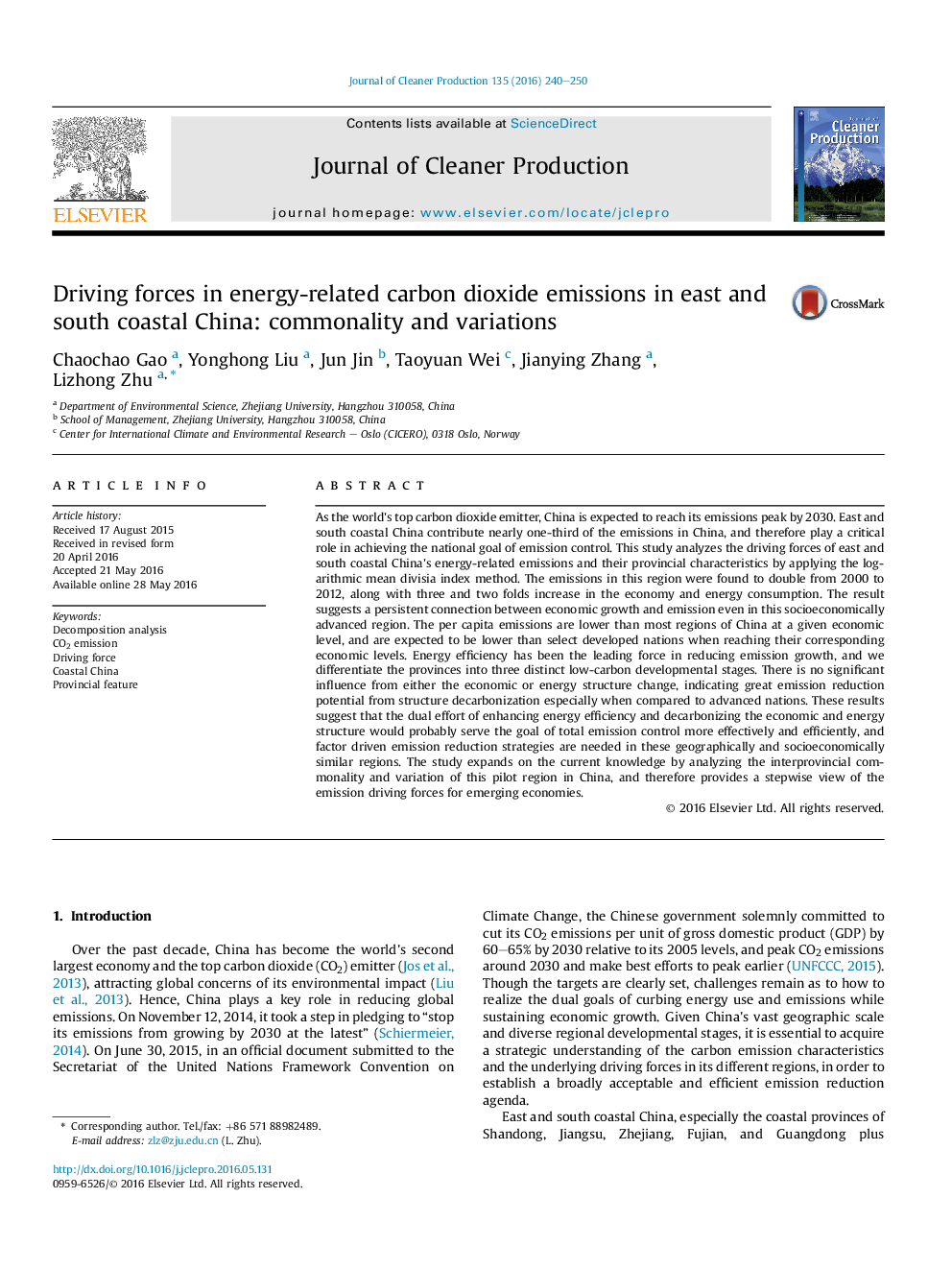| کد مقاله | کد نشریه | سال انتشار | مقاله انگلیسی | نسخه تمام متن |
|---|---|---|---|---|
| 8101134 | 1522115 | 2016 | 11 صفحه PDF | دانلود رایگان |
عنوان انگلیسی مقاله ISI
Driving forces in energy-related carbon dioxide emissions in east and south coastal China: commonality and variations
ترجمه فارسی عنوان
نیروهای رانندگی در انتشار گاز دی اکسید کربن مرتبط با انرژی در شرق و جنوب چین ساحلی: مشترکات و تغییرات
دانلود مقاله + سفارش ترجمه
دانلود مقاله ISI انگلیسی
رایگان برای ایرانیان
کلمات کلیدی
ترجمه چکیده
انتظار می رود چین تا سال 2030 به بالاترین حد خود برسد، به عنوان بزرگترین منبع دی اکسید کربن در جهان، چین تقریبا یک سوم انتشار گازهای گلخانه ای در چین را تأمین می کند و بنابراین نقش مهمی در دستیابی به هدف ملی کنترل انتشار دارد. در این مطالعه، با استفاده از روش لگاریتمی متوسط شاخص دوزیه، نیروهای محرکه انتشار گازهای گلخانه ای چین و مناطق ساحلی چین و خصوصیات استان آنها را تحلیل می کنند. انتشار گازهای گلخانه ای در این منطقه طی سال های 2000 تا 2012 دو برابر افزایش یافت و سهم و دو برابر افزایش در اقتصاد و مصرف انرژی بود. نتیجه نشان می دهد که پیوسته بین رشد اقتصادی و انتشار حتی در این منطقه پیشرفته اجتماعی و اقتصادی است. انتشار گازهای گلخانه ای در سرتاسر جهان از حد اکثر مناطق چین در یک سطح اقتصادی معینی پایین تر است و انتظار می رود که در مقایسه با سطوح اقتصادی متفاوتی که کشورهای توسعه یافته انتخاب کرده اند، کمتر از آن باشند. بهره وری انرژی، نیروی پیشرو در کاهش رشد انتشار بوده است، و استانها را به سه مرحله متمایز از مراحل توسعه کم کربن تقسیم می کنیم. هیچ تأثیر قابل توجهی از تغییر ساختار اقتصادی یا انرژی وجود ندارد، که نشان دهنده پتانسیل کاهش انتشار گازهای بزرگ از ساختار کربن است، به خصوص در مقایسه با کشورهای پیشرفته. این نتایج نشان می دهد که تلاش های دوگانه ای برای افزایش بهره وری انرژی و کاهش میزان ساختار اقتصادی و انرژی احتمالا به هدف کنترل کلی انتشار می انجامد به طور موثر و کارآمد، و استراتژی های کاهش انتشار فاکتور در این مناطق جغرافیایی و اجتماعی- اقتصادی مشابه مورد نیاز است. این مطالعه با استفاده از تجزیه و تحلیل مشترک و تنوع بین این منطقه آزمایشی در چین گسترش یافته است و به همین دلیل دیدگاه گام به گام از نیروهای راندمان انتشار برای اقتصادهای در حال ظهور را فراهم می کند.
موضوعات مرتبط
مهندسی و علوم پایه
مهندسی انرژی
انرژی های تجدید پذیر، توسعه پایدار و محیط زیست
چکیده انگلیسی
As the world's top carbon dioxide emitter, China is expected to reach its emissions peak by 2030. East and south coastal China contribute nearly one-third of the emissions in China, and therefore play a critical role in achieving the national goal of emission control. This study analyzes the driving forces of east and south coastal China's energy-related emissions and their provincial characteristics by applying the logarithmic mean divisia index method. The emissions in this region were found to double from 2000 to 2012, along with three and two folds increase in the economy and energy consumption. The result suggests a persistent connection between economic growth and emission even in this socioeconomically advanced region. The per capita emissions are lower than most regions of China at a given economic level, and are expected to be lower than select developed nations when reaching their corresponding economic levels. Energy efficiency has been the leading force in reducing emission growth, and we differentiate the provinces into three distinct low-carbon developmental stages. There is no significant influence from either the economic or energy structure change, indicating great emission reduction potential from structure decarbonization especially when compared to advanced nations. These results suggest that the dual effort of enhancing energy efficiency and decarbonizing the economic and energy structure would probably serve the goal of total emission control more effectively and efficiently, and factor driven emission reduction strategies are needed in these geographically and socioeconomically similar regions. The study expands on the current knowledge by analyzing the interprovincial commonality and variation of this pilot region in China, and therefore provides a stepwise view of the emission driving forces for emerging economies.
ناشر
Database: Elsevier - ScienceDirect (ساینس دایرکت)
Journal: Journal of Cleaner Production - Volume 135, 1 November 2016, Pages 240-250
Journal: Journal of Cleaner Production - Volume 135, 1 November 2016, Pages 240-250
نویسندگان
Chaochao Gao, Yonghong Liu, Jun Jin, Taoyuan Wei, Jianying Zhang, Lizhong Zhu,
